|
[ Back ] [ Home ] [ Up ] [ Next ]
|
Click any picture to
enlarge; then close out of that window to return here.
|
|
GUATEMALA
Part 5: Miscellany
|
|
|
|

 Auto
Hotels
("rooms for cars") are a common site outside cities and along rural highways
in Central America. They are motel rooms - suitably available by the
hour - with an enclosed garage below each room and private entry way
upstairs. Auto
Hotels
("rooms for cars") are a common site outside cities and along rural highways
in Central America. They are motel rooms - suitably available by the
hour - with an enclosed garage below each room and private entry way
upstairs.
|
|

 Another
Guatemalan past time, Coffee,
is a major export crop, grown
in 7 regions in Guatemala (right). We visited the Coffee Museum, and
21-acre working finca (plantation) in Jocotenango. It is one of
the 25 fincas in the Antigua area, where we had an informative tour
by a young man speaking great English. Another
Guatemalan past time, Coffee,
is a major export crop, grown
in 7 regions in Guatemala (right). We visited the Coffee Museum, and
21-acre working finca (plantation) in Jocotenango. It is one of
the 25 fincas in the Antigua area, where we had an informative tour
by a young man speaking great English.
 Coffee
trees are delicate and are grown under avocado and other trees for shade.
It takes 3 years for a coffee tree to produce coffee beans, and it can
produce Coffee
trees are delicate and are grown under avocado and other trees for shade.
It takes 3 years for a coffee tree to produce coffee beans, and it can
produce
 for
30 - 40 years. Coffee "cherries", the red bean, are harvested by hand
December through February. A worker gets paid Q25 (US$3.30) for each
100 pounds picked - and he can pick about 100 to 150 pounds
of cherries a day.
Cherries are then dried in parchment (1 week on the patio) producing the
dried bean. It is split open using a bicycle-type foot-powered machine
producing the green bean, which is then roasted, and maybe ground.
The whole process takes about two weeks. Cherry skins are used to make
the Mexican liqueur Kahlua. for
30 - 40 years. Coffee "cherries", the red bean, are harvested by hand
December through February. A worker gets paid Q25 (US$3.30) for each
100 pounds picked - and he can pick about 100 to 150 pounds
of cherries a day.
Cherries are then dried in parchment (1 week on the patio) producing the
dried bean. It is split open using a bicycle-type foot-powered machine
producing the green bean, which is then roasted, and maybe ground.
The whole process takes about two weeks. Cherry skins are used to make
the Mexican liqueur Kahlua.
One coffee tree (they're really more
like a bush) produces enough beans
for 40 cups of coffee: 1 coffee tree produces --> 6.5 lbs of
cherries --> 1.5 lbs dried beans --> 1.25 lbs green
beans --> 1 lb roasted --> 40 cups of coffee.
Doing the math, only 15% of what is picked is used. Guatemala exported
5 million 150 pound bags of coffee in 2004. If you pay a $1 for a cup
of coffee, 84¢
goes to the consuming country and only 16¢ goes to the producing country to
cover labor, plantation and exporting costs. Based on the above rough
figures from our tour, that comes out to $4.8 billion flowing into Guatemala's economy.
Guatemala is 6th in the world in
production (4%) behind Brazil, Colombia and Viet Nam(?). It is ranked
3rd in the world in taste behind Ethiopia and Kenya.
The more the bean is
roasted, the resulting cup of coffee is less acidic, less aromatic but
fuller flavor. What was also interesting is that the stronger
the coffee, the less caffeine it has in it.
|
|
Jade
is a stone found in large quantity in Guatemala. In Antigua, there are
many
 nice jade stores, some which offer little tours, which we did.
Indigenous jade comes in green, white, black and blue, and in very recent
years they have discovered lavender (ring at right) and orange jade (discovered, we were told,
after hurricane Stan). Jade is naturally light green and changes colors
when it touches other minerals. Jade is a very hard stone and can only
be cut with a diamond. On the hardness scale with diamond being a
"10", jade is "6.5" - "8". Jade can be translucent, and holding it up
to a bright light reveals all sorts of interesting colors and qualities. nice jade stores, some which offer little tours, which we did.
Indigenous jade comes in green, white, black and blue, and in very recent
years they have discovered lavender (ring at right) and orange jade (discovered, we were told,
after hurricane Stan). Jade is naturally light green and changes colors
when it touches other minerals. Jade is a very hard stone and can only
be cut with a diamond. On the hardness scale with diamond being a
"10", jade is "6.5" - "8". Jade can be translucent, and holding it up
to a bright light reveals all sorts of interesting colors and qualities.
Jade can only be cut
on straight lines due to its physical properties. To achieve rounded surfaces it must be ground using
diamond dusted belts. The ancient Mayas believed that jade gave
afterlife and accordingly buried dead with a piece of jade under the tongue;
wealthier were buried with jade masks, jewelry and other items as offerings.
The Mayas used sticks and stones to "drill" into and shape their jade.
Seeing the modern day process and how hard the stone is gives new
appreciation to the skill (and perseverance) of the ancient Maya.
|
|
"Why do
Guatemaltecos litter? " A
plausible explanation we've heard is
that not too many years ago, before plastic made its way down here,
everything was "packaged" in biodegradable material, e.g., food wrapped in
corn husks or banana leaves, liquid in coconut shells, etc. When done
they threw the "container" away which soon returned to the earth.
Accustomed to that, that's why they throw plastic everything everywhere --
they haven't been educated on the difference. (In all fairness, Venezuela was much worse, though.)
|
|
"Why do Guatemaltecos do everything the
hard way?"
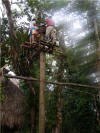 Early on in our stay in Guatemala we observed that rarely
are labor-saving devices used. Instead of using wheelbarrows,
dollies, weed whackers and lawnmowers, they use buckets, backs and machetes,
respectively. The owner of Monkey Bay Marina
has just finished building a small "kitchen" palapa (called
ranchito here) and is currently redoing part of the dock,
both projects requiring driving 30 ft. pilings into the river bottom.
He offered to rent a pile driver, but the crew strongly objected. He
explained to us that doing it the old fashioned way is job security for them,
ensuring work for a longer period of time. Wages are very low, so that
is not an issue for the owner. Pictured at right is the Early on in our stay in Guatemala we observed that rarely
are labor-saving devices used. Instead of using wheelbarrows,
dollies, weed whackers and lawnmowers, they use buckets, backs and machetes,
respectively. The owner of Monkey Bay Marina
has just finished building a small "kitchen" palapa (called
ranchito here) and is currently redoing part of the dock,
both projects requiring driving 30 ft. pilings into the river bottom.
He offered to rent a pile driver, but the crew strongly objected. He
explained to us that doing it the old fashioned way is job security for them,
ensuring work for a longer period of time. Wages are very low, so that
is not an issue for the owner. Pictured at right is the
 "human pile
driver" - be sure to enlarge it (or watch the slide show). "human pile
driver" - be sure to enlarge it (or watch the slide show).
It has been interesting to watch the whole process from
start to finish. I've been fascinated with the thatched roofs in
Guatemala, so seeing it first hand, along with the replacement of the
owner's thatched roof on his house, has been educational. And I got it all here
. . .
|
|
"Have
we been robbed or had bad things happen to us here?"
The only bad thing that happened
to us is ATM fraud. We're usually pretty careful but had become
complacent in our now familiar surroundings on the Rio.
Steve went to the
usual ATM on Sunday by himself. The machine ate his card.
Another person attempted to help (Steve did not reveal his PIN in any way)
to no avail, but when the other guy tried his own card, Steve saw the other
guy's card come back out - looking back we think Steve's card came out with
but under his card, as a plastic "shim" fell on the floor. The next
day, along with another couple who lost their card, the bank said no cards
had been withheld by the machine. Somehow the PIN code was cracked and
the bad guy maxed out the ATM and Debit card for 3 days. "For 3 days",
you ask, "didn't you call it in?"
Sure, but our financial
institution, that has 24x7 telephone customer support service, was closed
due to the Labor Day weekend - giving the employees a holiday off!
Couldn't believe it. Anyway, they promptly reimbursed our account
without much hassle. The lesson learned, but previously forgotten, is: Only use the ATM when the bank is open; both of us go
together depending on location
of machine relative to bank personnel; and use an ATM machine, if possible, where you can keep your
fingers on your card as opposed to one that sucks it in completely for
processing.
|
|
Medley of Pictures
from Guatemala
|
| |
 |
|
 |
Artist painting
arch in Antigua. |
|
|
 |
 |
 |
The
boys waiting for the girls. |
| |
| In Jocotenango (near Antigua) there is
the
Coffee - Music - Cultural Museums: |
 |
The Coffee Museum:
(see separate section above) |
| |
| The Music Museum:
A traditional Guatemalan Marimba, played like a xylophone;
varying sized gourds create the music. |
 |
Horn from animal
skull.
Drums from hollow, "H"
slotted logs |
 |
 |
| |
| The Cultural
Museum: Another presentation of Maximόn |
 |
 |
Traditional
village dress |
| |
 |
Typical (large)
cemetery with brightly painted mausoleums and tombs |
 |
Frida Kahlo,
famous Mexican artist: popular Frida's restaurant in Guate and
Antigua |
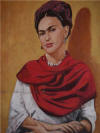 |
| |
| A Chiltepe Trolley tour through the
heart of Guatemala City |
 |
Yes, those are
piñatas, hundreds of
them surround the central plaza area |
 |
| |
 |
|
 |
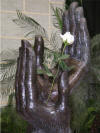 |
| |
|
Guiquil (whees-keel), a
popular and tasty squash |
 |
Crypt at Santo Domingo Monastery ruins |
 |
|
|
 |
|
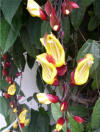 |
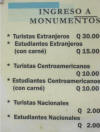 |
Typical in
Guatemala, foreigners pay a lot more for admissions to various
attractions |
| |
| Saying our
good-byes to our favorite Antiguan street vendor, Vincy, and friend Flor. If we could . . .
and were so inclined to adopt . . . this cutie would be the one. Very
smart, good English, and one heck of a salesperson! |
 |
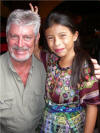 |
. . . and a sense of
humor! |
| |
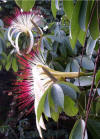 |
|
 |
Lifespan of most mariposas is 2-3 weeks; black and red or green are
poisonous to predators. 700 species. |
|
|
|
Back at Monkey Bay: |
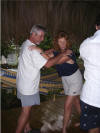 |
Cruiser couple
attempts to teach us to Tango |
 |
Girls' weekly Baja Rummy game (with
Paco the parrot) |
|
|
|
Cooking lesson: Mojarra
Yanira (wife of groundskeeper) shows
us how to prepare whole fish, marinated with heavily seasoned onions,
garlic, lime juice and lots of spices. (Click
here for recipe) |
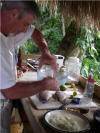 |
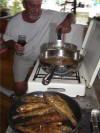 |
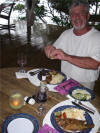 |
|
|
 |
Our
new kitchen ranchito |
 |
This
little boy was flying a kite while mom drives the cayuca |
|
|
|
Paco, marina
manager's pet |
 |
|
 |
|
|
 |
Huge cathedral in Antigua; earthquake damage
of late 1700's |
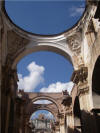 |
 |
Cool spiral plant - leaves only grow
on one side |
|
|
|
This "pod" used by natives for lipstick |
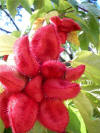 |
|
Bird's net |
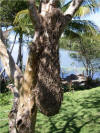 |
|
|
|
At Christmas, cemeteries are decorated with lots of fresh
poinsettias and other greenery |
 |
|
 |
|
|
|
|
 Our fall on the Rio included a big
traditional Thanksgiving dinner at Mario's Marina cooked by fellow cruisers,
preceded by a light brunch of quiche and ARGO's infamous Bloody Mary's at
Monkey Bay. Christmas was spent in the lovely Antigua Our fall on the Rio included a big
traditional Thanksgiving dinner at Mario's Marina cooked by fellow cruisers,
preceded by a light brunch of quiche and ARGO's infamous Bloody Mary's at
Monkey Bay. Christmas was spent in the lovely Antigua at a very cool
house rented by Canadian/Greek cruiser friends, Donna & Cosmos (left),
s/v Koukla. On Christmas Eve Day
the guys surprised the girls when a masseuse showed up at the house with her
table! Although the city was not decorated in Christmas lights as
heavily as we had expected, the spirit was certainly there as we enjoyed the
traditional giant-costume parade (right). We
attended at a very cool
house rented by Canadian/Greek cruiser friends, Donna & Cosmos (left),
s/v Koukla. On Christmas Eve Day
the guys surprised the girls when a masseuse showed up at the house with her
table! Although the city was not decorated in Christmas lights as
heavily as we had expected, the spirit was certainly there as we enjoyed the
traditional giant-costume parade (right). We
attended
_small.JPG) midnight mass which was held at 10:00 p.m. as the priests want to
be home by midnight. For the Guatemaltecos Christmas begins at
midnight and continues on for hours into the early morn, starting with a
half hour of unrelenting fireworks and firecrackers (and probably gun shots,
too). midnight mass which was held at 10:00 p.m. as the priests want to
be home by midnight. For the Guatemaltecos Christmas begins at
midnight and continues on for hours into the early morn, starting with a
half hour of unrelenting fireworks and firecrackers (and probably gun shots,
too).
 We had never seen, nor heard, so much at one time - the entire
sky around us was filled as were the surrounding mountainside villages.
We observed all from the "safety" of our house's rooftop terrace,
although Cosmos insisted on setting off several packs of firecrackers in the street.
New Years '07
(left) was ushered in at Monkey Bay with a big party thrown by the owner
and the serving of the holiday's traditional dish of tasty spicy fish soup
(right). We had never seen, nor heard, so much at one time - the entire
sky around us was filled as were the surrounding mountainside villages.
We observed all from the "safety" of our house's rooftop terrace,
although Cosmos insisted on setting off several packs of firecrackers in the street.
New Years '07
(left) was ushered in at Monkey Bay with a big party thrown by the owner
and the serving of the holiday's traditional dish of tasty spicy fish soup
(right).
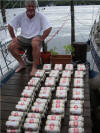 A
few weeks were spent leisurely provisioning (left) and cleaning ARGO.
Although she had been cleaned periodically while at Monkey Bay, we gave her
her last thorough cleaning for a while. Being kept in fresh water,
rust was not a problem, but the humid environment invites green stuff and
mildew to accumulate on the exterior. (We ran air
conditioning/humidifier inside so not a problem there.) For
US$1.30/hour, good and dependable local labor helped with the exterior
cleaning, well worth it! A
few weeks were spent leisurely provisioning (left) and cleaning ARGO.
Although she had been cleaned periodically while at Monkey Bay, we gave her
her last thorough cleaning for a while. Being kept in fresh water,
rust was not a problem, but the humid environment invites green stuff and
mildew to accumulate on the exterior. (We ran air
conditioning/humidifier inside so not a problem there.) For
US$1.30/hour, good and dependable local labor helped with the exterior
cleaning, well worth it!
We managed to unplug the power cord and
cut the docks lines mid January, spending the first night down river in
"Texan Bay", a lovely and peaceful bay being developed by a cruiser couple, Sherry & Mike, from,
you guessed it, Texas. We were their first paying customer at their
restaurant, and they are currently putting in docks to accommodate
both the local and
cruising boats. The bay, set back off the Golfete, has
small tributaries through the jungle used by locals commuting by cayuco
(dugout canoe) to school and elsewhere, and by us to explore by dinghy.
Way back in there it opens up into a lake or large lagoon.
 The
next day we continue through "Tarzan" country (left). We crossed the shallow mud bar at the
mouth of the Rio Dulce river at Livingston at dusk with a high-high tide, as the
morning highs were not enough for us with our 6'4" draft. There was
also a 2-3 foot chop at the bar, causing ARGO to hobby-horse (a rocking
forward-backward motion) across the bar. We did get stuck several
times but wind-wave action would eventually lift us up and allowed us to
wiggle free. (Just in case, we had the contact info of a guy who
will tow boats off/through the bar when necessary.) We crossed the
large bay in darkness, anchoring off the far shore using our previously
acquired waypoints. Next day we headed to Belize . .
. The
next day we continue through "Tarzan" country (left). We crossed the shallow mud bar at the
mouth of the Rio Dulce river at Livingston at dusk with a high-high tide, as the
morning highs were not enough for us with our 6'4" draft. There was
also a 2-3 foot chop at the bar, causing ARGO to hobby-horse (a rocking
forward-backward motion) across the bar. We did get stuck several
times but wind-wave action would eventually lift us up and allowed us to
wiggle free. (Just in case, we had the contact info of a guy who
will tow boats off/through the bar when necessary.) We crossed the
large bay in darkness, anchoring off the far shore using our previously
acquired waypoints. Next day we headed to Belize . .
.
continued . . .
|
|
Click here to continue to
Guatemala Part 6
on Pictures/Journal - page 25. |
[ Back ] [ Home ] [ Up ] [ Next ]
[ Top of page ]
|
![]()